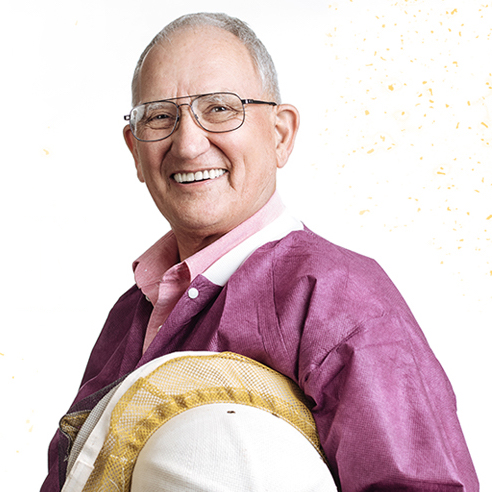The Buzz on Pollen
A Q&A with Dr. Vaughn Bryant, one of the world's prominent palynologists.

Education: B.A. Geography (1964), M.A. Anthropology (1966), Ph.D. Botany (1969), The University of Texas at Austin.
Research Interests: Palynology, archaeology and anthropology, especially regarding prehistoric diets and forensics.
WHAT IS PALYNOLOGY?
Palynology is the study of pollen grains and spores found in honey and archaeological or geological deposits. There are more than 350,000 plants worldwide that bees utilize, and each plant species produces a unique pollen grain. Pollen is mostly invisible to the naked eye, but when studied under a microscope, it can reveal a multitude of information.
CAN FORENSIC PALYNOLOGY SOLVE CRIMES?
Since pollen can survive harsh conditions, it can reveal important clues as evidence. In 2006, I was contacted by a medical examiner in Rochester, New York, to work on an unsolved murder case from 1979. Investigators shipped the victim’s clothing to me, which I analyzed for pollen grains. I determined that the young girl was not from New York, but must have come from southern Florida or around San Diego, California, based on pollen grains found in her clothing’s pocket lint that had survived, even after all those years. In 2015, she was identified as being from southern Florida.
HOW DO YOU ANALYZE POLLEN GRAINS?
We use a special vacuum to gather pollen from the sample while wearing a full-body forensic suit to avoid contamination. Then we place the vacuumed filter in a test tube and treat it with a series of acids that destroy everything but the pollen. The result is a vial containing the pollen grains, which are microscopically studied, identified and then matched to the plants from which they originated.
WHAT IS YOUR MOST MEMORABLE CASE?
After 9/11, the CIA asked me to analyze samples to help track down terrorists using forensic pollen techniques. They sent me random objects but never said where they came from or the item’s significance.
One time, they sent a 36-inch shoelace taken from a terrorist’s boot, which I traced back to Iran through pollen analysis. Another item was a prayer blanket, which we determined had been used in South Pakistan. I even studied captured weapons, cell phones, IEDs and car air filters to see where they’d been. I examined hundreds of samples and traveled to Langley, Virginia, twice per year. I did this for 10 years, unaware I was searching for Osama bin Laden, until Navy SEALs captured and killed him in 2011.
IS YOUR WORK USED IN THE WAR ON DRUGS?
The U.S. Department of Homeland Security reached out to me in 2011 when it heard that pollen analysis could trace the origins of illegal drugs entering the U.S., such as marijuana, cocaine, heroin and methamphetamine. One time, I processed several kilos of cocaine with a street value of about $3 million. From pollen analyses, I can often determine where illegal drugs originated—such as states like Sonora, Sinaloa, Chihuahua or Coahuila, Mexico.
